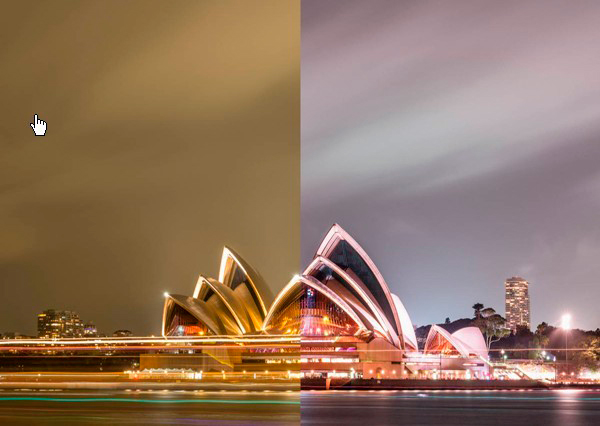Canon RF 70-200mm f/4L IS USM lens
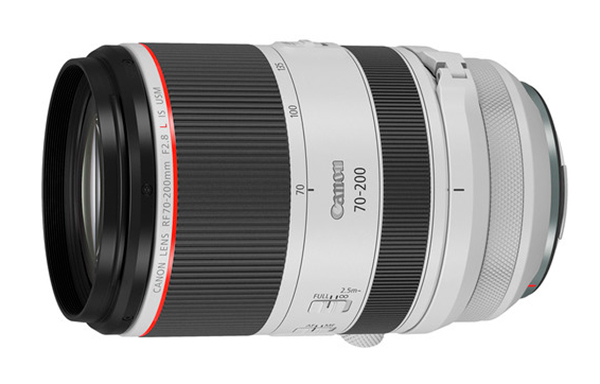
In summary
Offering a similar level of performance to the much more expensive RF 70-200mm f/2.8L IS USM lens, the RF 70-200mm f/4L IS USM represents a wise choice for photographers who don’t need the one-stop advantage the f/2.8L lens provides as well as those looking for a more portable lens for hand-held shooting.
The 70-200mm zoom range is a popular extension to 24-70mm zooms and works well for sports and wildlife shooting at longer focal lengths and portraiture at focal lengths between 70mm and about 105mm, where it provides a natural-looking perspective.
Full review
Announced on 4 November 2020, Canon’s RF 70-200mm f/4L IS USM is a smaller, lighter and more affordable alternative to the RF 70-200mm f/2.8L IS USM lens, which we reviewed in January 2020. The f/4 lens is approximately 32% shorter and 11% lighter than its EF equivalent, thanks to its extending inner barrel. Combining L-series weather-resistance with the classic white barrel design, it also comes with a matching white lens hood. Like the RF f/2.8 lens, it’s not compatible with the RF teleconverters. But unlike the f/2.8 lens, it comes without a tripod collar and foot because it’s small and light enough not to need them.
Angled view of the RF 70-200mm f/4L IS USM lens, shown without its supplied lens hood. (Source: Canon.)
The optical design of the RF 70-200mm f/4L IS USM lens contains 16 elements in 11 groups and includes four UD (ultra-low dispersion) lenses to reduce chromatic aberrations and coloured fringing and provide clearer colour rendition. Most of the lens elements are located closer to the camera body to provide better balanced handling.
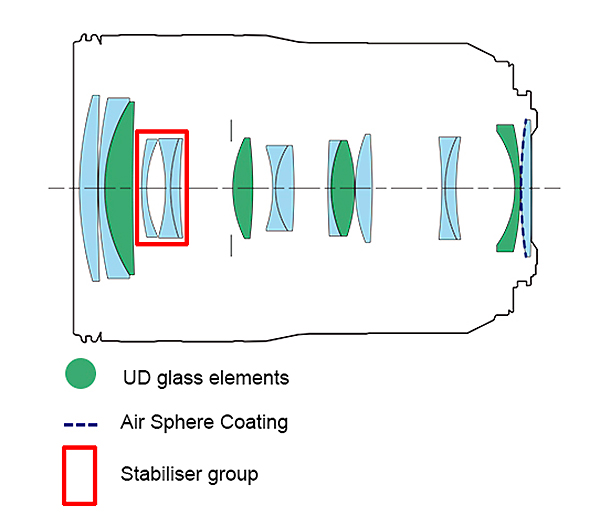
The optical diagram for the RF 70-200mm f/4L IS USM lens showing the positions of exotic glass elements, stabilising elements and the Air Sphere Coating. (Source: Canon.)
Proprietary Air Sphere Coating (ASC) has been applied to lens elements to suppress ghosting and flare, while the front and rear elements have protective fluorine coatings to resist grease and make them easier to clean. The built-in Optical Image Stabiliser provides up to five stops of shake correction or up to 7.5 stops when the lens is paired with an EOS R-type body with IBIS.
Three selectable stabiliser modes are available. Mode 1 corrects vibrations in all directions and is suitable for relatively stationary subjects. Mode 2 corrects vertical camera shake and is used while panning. Mode 3 only applies correction during an exposure and is used when following fast and irregularly moving subjects, making it ideal for photographing ball sports.
Autofocusing is driven by a Dual Nano USM system that drives the two lens groups separately. Each motor is electronically controlled and works independently to adjust the focusing and floating lens groups to prevent shifts in the focus position while zooming and during close-up shooting. This system puts less reliance on the mechanical system, while contributing to a smaller lens design.
The floating focus element also reduces the focusing distance to decrease breathing, providing fast, consistent and reliable performance. Full-time manual focus control is available when working in the one-shot AF mode and the lens can focus to a minimum distance of 60 cm over the entire zoom range.
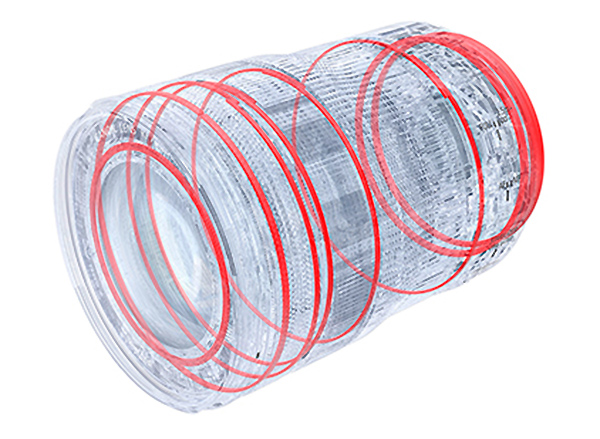
This diagram shows the positions of the weather-resistant sealing in the RF 70-200mm f/4L IS USM lens. (Source: Canon.)
Like the RF 70-200mm f/2.8 L IS USM, the RF 70-200mm f/4L IS USM lens is dust and water resistant and has a fluorine coating on the surfaces of the front and rear elements to resist oil and water and make them easy to clean with a dry cloth. The shorter and lighter design allows the lens to more easily be stowed away in a camera bag when not in use.
Who’s it For?
The 70-200mm zoom range is a popular extension to 24-70mm zooms and works well for sports and wildlife shooting at longer focal lengths and portraiture at focal lengths between 70mm and about 105mm, where it provides a natural-looking perspective.
Smaller and lighter – as well as significantly cheaper – than the RF 70-200mm f/2.8 L IS USM lens, the RF 70-200mm f/4L IS USM lens should have a much wider appeal, particularly for sports and wildlife photographers. While not as fast as the f/2.8 lens, its shorter close-focusing distance should make it more versatile.
Physically, it’s a good match with the EOS R6, which we used for our tests, although it is also well-balanced on the entry-level EOS RP. Attaching the lens to the EOS R5 or EOS R6 activates the Coordinated Control IS system, which combines the Optical IS with the In-Body Image Stabilizer (In-Body IS) to achieve up to 7.5 stops of image stabilisation.
Compared to the f/2.8 Lens
Since they target the same end users, we thought it was worthwhile to provide a comparison between the f/4 and f/2.8 lenses. The table below shows key specifications and we’ve provided an illustration of size differences below it.
| RF 70-200mm f/4 L IS USM | RF 70-200mm f/2.8 L IS USM | |
| Announced | November 2020 | February 2019 |
| RRP (AU$) on release | $3079 | $4899 |
| Diameter | 83.5 | 89.9 |
| Min. /Max. length | 119/174 mm | 146/204 mm |
| Weight | 695 grams | 1070 grams |
| Stabiliser | Yes, 5 stops (CIPA standard) | Yes, 5 stops (CIPA standard) |
| Optical design | 16 elements in 11 groups | 17 elements in 13 groups |
| Exotic elements | 4 UD | 2 aspherical, 4 UD and 1 Super UD |
| Lens coatings | Air Sphere Coating and fluorine | Subwavelength Structure Coating and fluorine |
| Focus drive | 2 Nano USM linear motors | 2 Nano USM linear motors |
| Minimum focus | 0.6 metres | 0.7 metres |
| Max. Magnification | 0.28x | 0.23x |
| Diaphragm blades | 9 | 9 |
| Distance information | No | No |
| Filter diameter | 77 mm | 77 mm |
| Teleconverter compatible | No | No |
Build and Ergonomics
The large mount diameter and short back focus distance of the RF mount have enabled Canon to design lenses that are significantly smaller but capable of better image quality than before. Like the f/2.8 that preceded it, the main barrel of RF70-200mm f/4L IS USM is built from engineering-quality plastic.
It carries a ‘Made in Japan’ label, along with the same white heat shield coating as the RF 70-200mm f/2.8 L IS USM, which reflects heat to keep the temperature inside the lens relatively low when shooting on hot days. Filters around the rings, switches, and extending/retracting parts of the lens provide weather-sealing to stop dust and moisture from entering the lens.
While the f/2.8 lens was small for its type, the f/4 lens is even smaller, as shown in the illustration below. In addition, the f/4 lens isn’t supplied with a tripod foot, indicating it’s designed mainly for hand-held shooting.
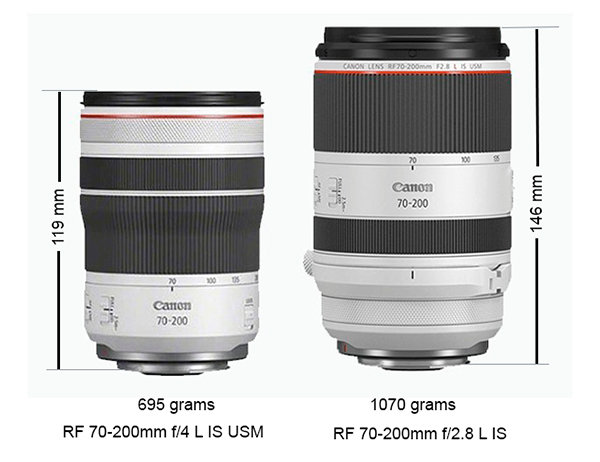
At just 83.5 x 119 mm (collapsed) and 695 grams, the f/4 lens is 27 mm shorter and 375grams lighter than the 89.9 x 146 mm (collapsed) and 1,070 gram weight of the RF 70-200mm f/2.8L lens.
It also comes with a matching lens hood that reverses over the barrel for storage and includes a locking button. Unlike the hood for the f/2.8 lens, there’s no sliding hatch for adjusting angle-critical filters, although there is a locking button.
A 13 mm wide black band at the front of the lens has a bayonet fitting for the lens hood on its outer side and threading for a 77 mm diameter filter on its inside. Immediately behind it is a 5 mm wide white band with a thin red branding ring around its trailing edge.
The customisable control ring is located just aft of the red band. It’s 11 mm wide and has a textured surface to provide a secure grip. This ring can be set to adjust one of the following camera functions: exposure compensation, shutter speed, aperture or ISO settings. Click stops give users feedback on how much the ring is turned.
The focusing ring begins about 6 mm behind the control ring. It’s 14 mm wide and covered by a rubber grip band with thin ridging. Focusing is driven electronically from the camera so the ring turns through a full circle when power is not supplied.
The zoom ring is located just behind the focusing ring. It’s 28 mm wide, with most of its length clad in a ridged rubber grip band that slopes inwards about half way along its length.
The trailing edge of the zoom ring is un-clad and carries focal length marks for the 70mm, 100mm, 135mm and 200mm positions, which line up against a grey mark on the fixed section of the lens barrel just behind the ring. The retracting design extends the inner barrel by approximately 57 mm when the lens is zoomed from the 70mm to the 200mm position.
Just behind the zoom ring is a 28 mm wide fixed section of the barrel that contains the main controls. There’s a zoom lock around the right hand side, while to the left are located (in descending order) the distance range selector, AF/MF focus mode switch, image stabiliser on/off switch and, finally, the three-position stabiliser mode selector.
The barrel then slopes in to the metal mounting plate with a red index dot at the junction for attaching and detaching it from the camera body. Just inside the junction is a rubber ring for excluding moisture and dust. The inner edge of the lens mount carries contacts for the 12-pin communication system that links the lens with the camera.
Performance
Our Imatest tests showed the review lens to be not quite at the standard of the RF 70-200mm f/2.8 L IS USM lens at wider apertures (which is to be expected). Nonetheless, resolutions measured for both JPEG and CR3.RAW files comfortably exceeded of expectations for the 20-megapixel sensor in the EOS R6 camera we used for testing across the image frame through to f/11, where diffraction began to take effect.
The close parallels between centre and edge resolution that we found with the f/2.8L lens weren’t replicated in the test results from the f/4 lens. But they were close enough for us to consider the lens an impressive performer, as shown in the graph of our test results below.
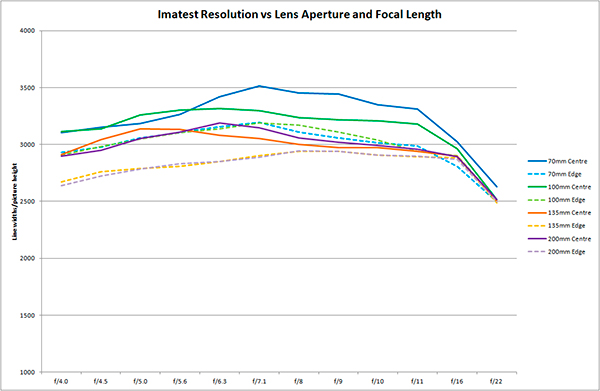
Lateral chromatic aberration remained well down in the ‘negligible’ band for both JPEGs and CR3.RAW files, confirming this lens is effectively free of this problem. The graph below shows the results from JPEG files. We found no coloured fringing in test shots taken with the review lens.
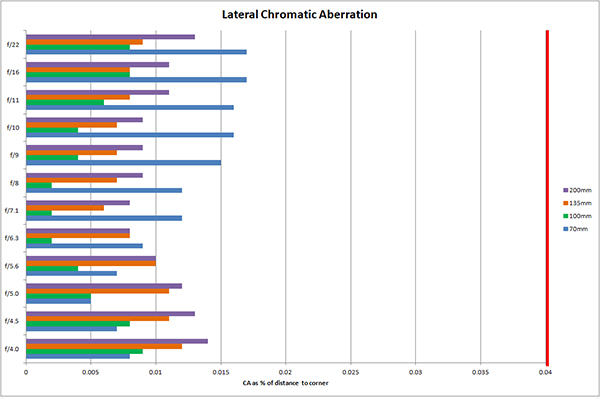
Autofocusing was as fast and accurate as we found with the f/2.8 lens. The only times we found it less than perfect were with very low contrast subjects, poorly-lit scenes with flickering lights and (briefly) when something came between the lens and a subject we were tracking while shooting video.
Because the camera provides built-in corrections for common aberrations, these were switched off when we carried out our tests. As usual, assessments of vignetting and distortion were, carried out on uncorrected raw files.
Very little vignetting could be seen in wide-aperture shots taken at 70mm but by 135mm, vignetting had become evident. It was quite noticeable at the 200mm focal length but was mostly eliminated by stopping down to f/5.6.
Like the f/2.8L lens, we found slight barrel distortion in uncorrected raw files captured at 70mm. It was effectively eliminated by the 100mm and 135mm focal lengths and transitioned to very slight pincushion distortion at 200mm. For JPEG files this aberration is automatically corrected by in-camera processing.
The deep, cylindrical lens hood eliminated most traces of ghosting and flare in backlit subjects and it was quite difficult to force the lens to flare when a bright light source was included within the frame.
Bokeh was mostly smooth and attractive with smooth out-of-focus rendering, although we found some outlining around bright highlights in contrasty conditions. Fortunately, highlights tended to remain as circular discs across most of the frame focus transitions in evenly-lit backgrounds were generally very smooth.
Conclusion
Please Login or Register to access the Conclusion.
SPECS
Picture angle: 34 degrees to 12 degrees (diagonal)
Minimum aperture: f/32
Lens construction:16 elements in 11groups (including 4 UD elements plus Air Sphere coating)
Lens mount: Canon RF
Diaphragm Blades: 9 (circular aperture)
Weather resistance: Yes (rubber ring on lens mount)
Focus drive: Dual independent Nano USM system
Stabilisation: Yes, up to 5 stops shake reduction (7.5 stops on EOS R5 or R6); 3 modes
Minimum focus: 60 cm
Maximum magnification: 0.28x
Filter size: 77 mm
Dimensions (Diameter x L): 83.5 x 119 mm
Weight: 695 grams
Standard Accessories: ET-83G lens hood, E-77II lens cap, LP1319 lens pouch
Distributor: Canon Australia; 1800 021 167
TESTS
Based on JPEG files taken with the EOS R6 camera.

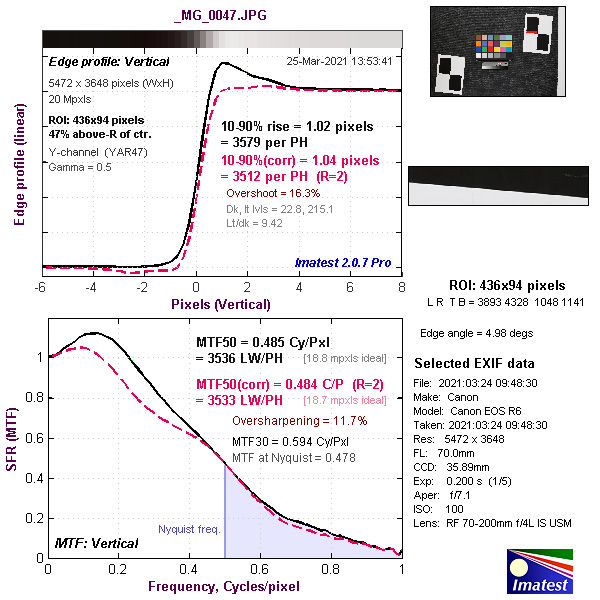
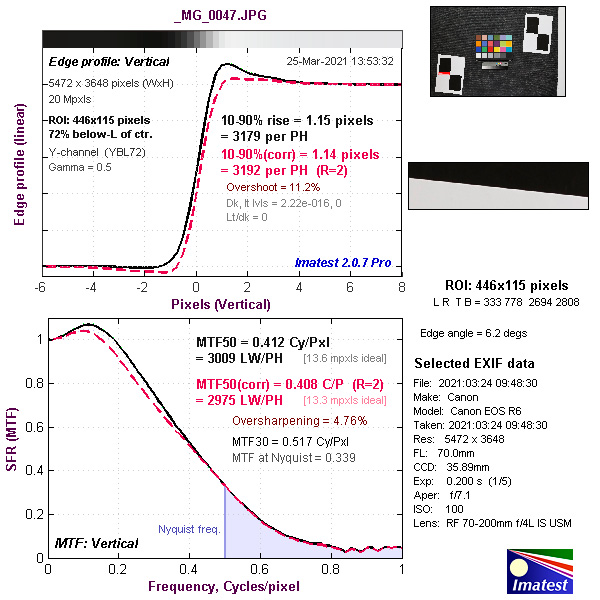
Based on CR3.RAW files recorded simultaneously.
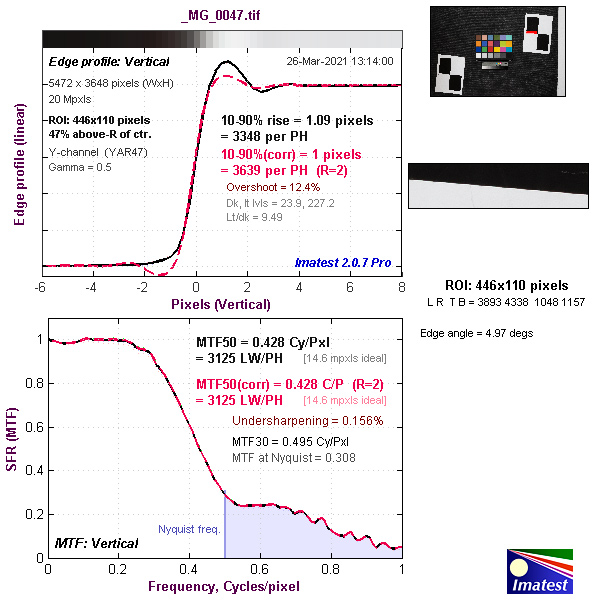
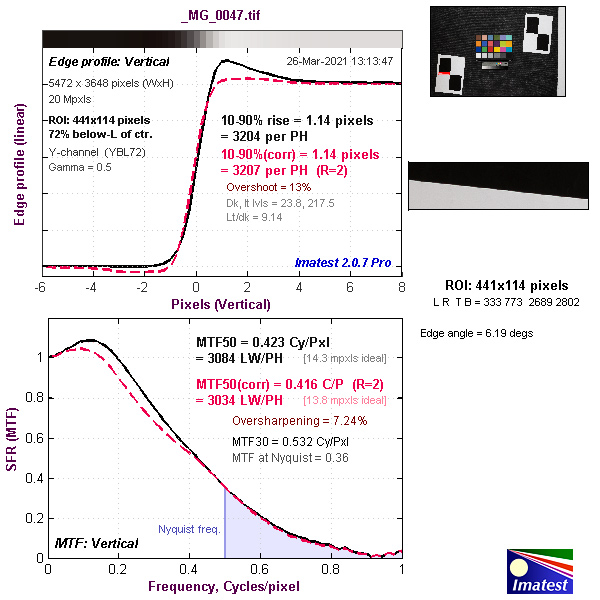
SAMPLES

Vignetting at 70mm, f/4.

Vignetting at 100mm, f/4.
Vignetting at 135mm, f/4.

Vignetting at 200mm, f/4.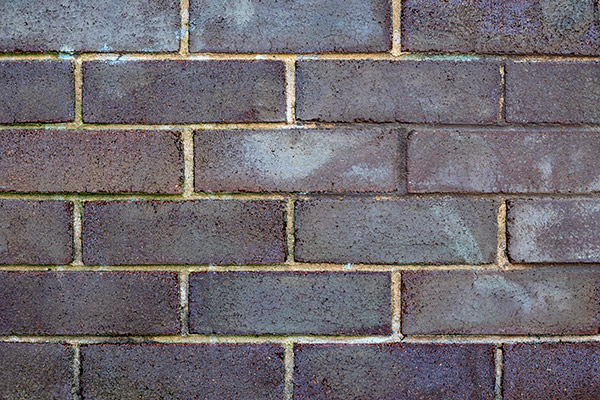
Rectilinear distortion at 70mm.
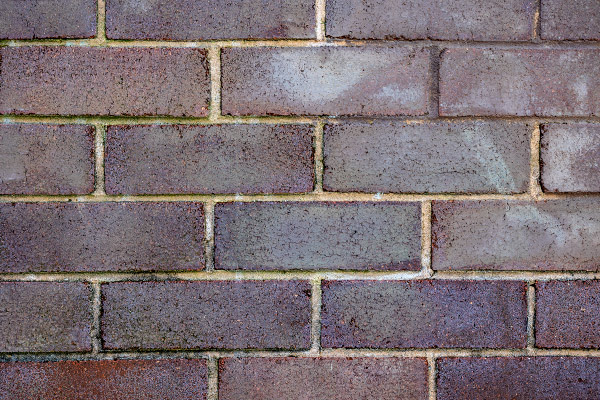
Rectilinear distortion at 100mm.
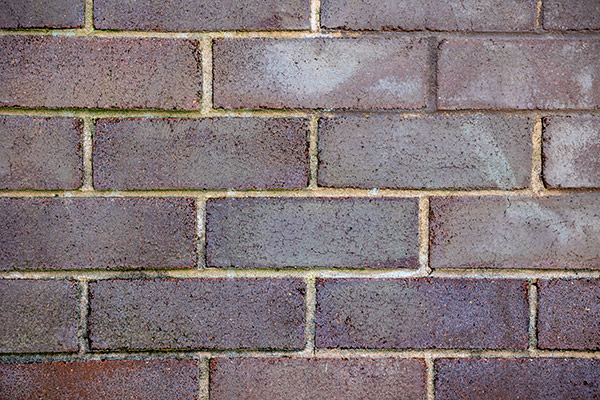
Rectilinear distortion at 135mm.
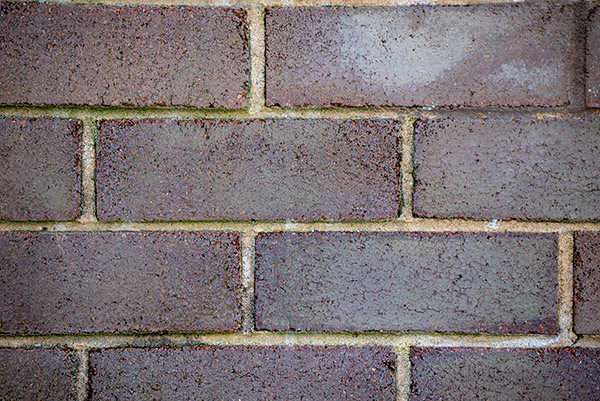
Rectilinear distortion at 200mm.

70mm focal length, ISO 100, 1/250 second at f/9.

Crop from the centre of the above image enlarged to 100% showing high resolution and no coloured fringing.

200mm focal length, ISO 100, 1/200 second at f/9.

Crop from the centre of the above image enlarged to 100% showing high resolution and no coloured fringing.
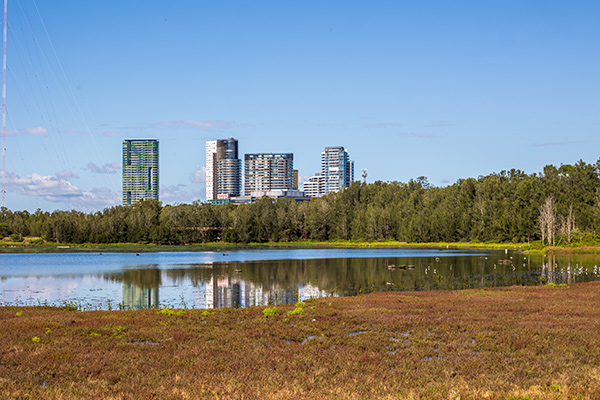
70mm focal length; ISO 100, 1/100 second at f/16.
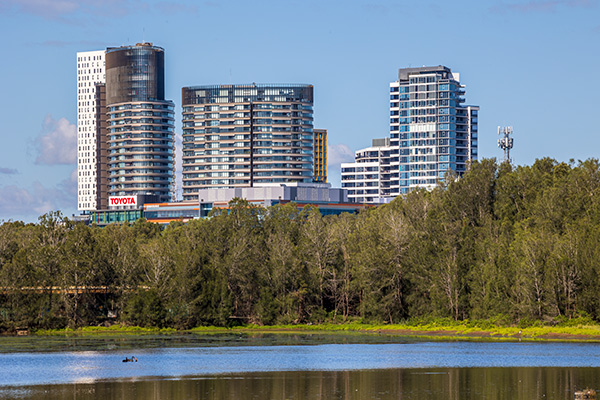
200mm focal length, ISO 100, 1/80 second at f/16.
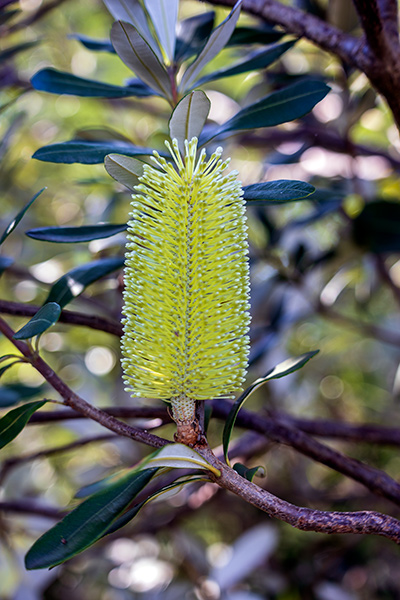
Close-up at 70mm focal length; ISO 100, 1/60 second at f/4.
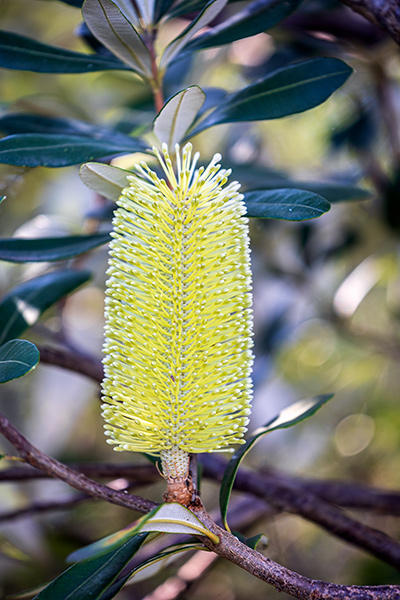
Close-up at 200mm focal length, ISO 100, 1/50 second at f/4.

Flare; 70mm focal length, ISO 100, 1/400 second at f/4.
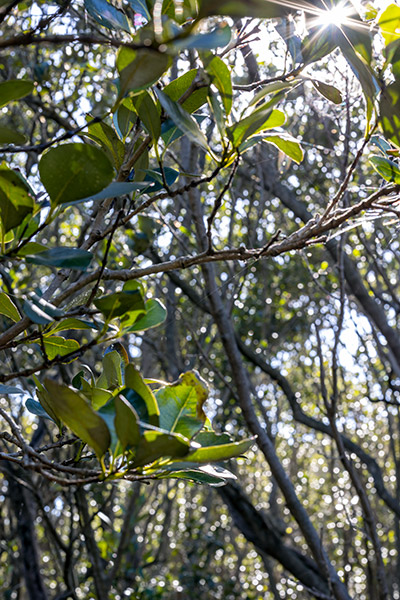
Sunstars in a contre-jour shot; 70mm focal length, ISO 100, 1/40 second at f/11.
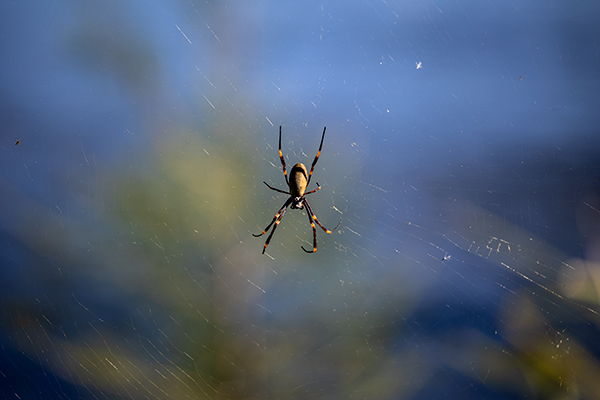
200mm focal length, ISO 100, 1/800 second at f/4.

200mm focal length, ISO 100, 1/1250 second at f/4.

191mm focal length, ISO 100, 1/60 second at f/4.

79mm focal length, ISO 100, 1/15 second at f/11.

70mm focal length, ISO 100, 1/10 second at f/11.
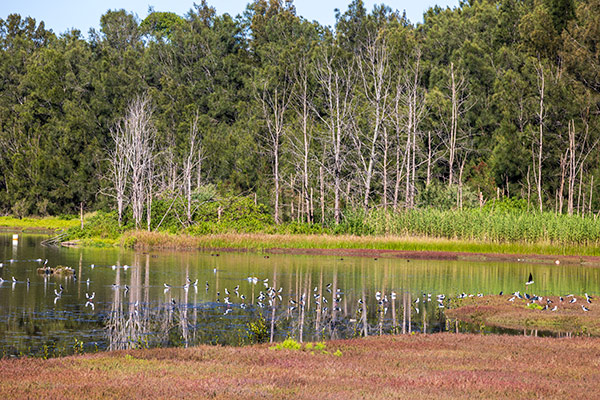
200mm focal length, ISO 100, 1/160 second at f/10.
Rating
RRP: AU$3079; US$1599
- Build: 9.0
- Handling: 9.0
- Image quality: 9.0
- Autofocusing: 8.9
- Versatility: 8.8
